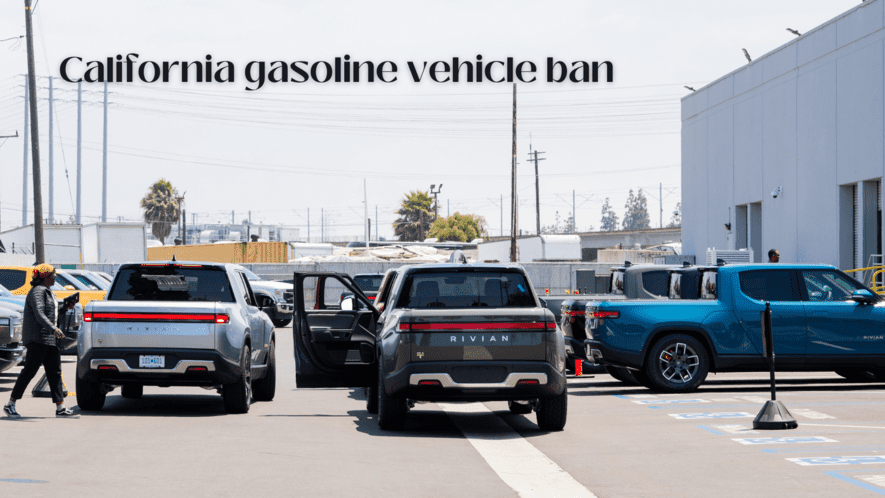The California Gasoline Vehicle Ban is a groundbreaking policy aiming to phase out the use of gasoline-powered cars in the state. With a focus on reducing greenhouse gas emissions and promoting sustainable transportation, the ban sets California on a path towards a greener, more sustainable future for generations to come.
As a landmark move in the state’s fight against climate change, California, the most populous state in the union and the epicentre of American auto culture, will prohibit the sale of new gasoline-powered automobiles starting in 2035.
- The rule, which was announced by the California Air Resources Board on Thursday, will compel automakers to accelerate the manufacturing of cleaner cars, pickup trucks, and SUVs starting in 2026 until sales of only zero-emission vehicles are permitted in the state.
- Once Governor Gavin Newsom announced a goal for 2020 to hasten the transition away from internal combustion engines, the vote was unanimous. In California, which has experienced record-breaking wildfires, droughts, and air pollution made worse by climate change, the transportation sector is the major contributor to glasshouse gas emissions.
- Beyond California, the ruling is anticipated to have wide-ranging effects and probably pave the door for other states to follow suit. At least 15 states, including Pennsylvania, New Jersey, and New York, have ratified California’s vehicle standards, which replaced earlier clean-car regulations.
- The rule, according to California Air Resources Board Chair Liane Randolph, will result in a 50% reduction in pollution from vehicles and light trucks by 2040, making it one of the state’s most significant air-cleansing initiatives to date.
- After 2035, the policy won’t prohibit people from continuing to drive gas-powered vehicles or from purchasing and reselling them on the used market. By 2035, the law will also let automakers to sell up to 20% of gas-powered plug-in hybrids.
However, the law gradually phases out these vehicles, mandating that by 2026, 35% of all new vehicle sales must be battery- or hydrogen-powered, and by 2030, 68%. The state reported that in 2022, more than 16% of new automobiles sold in California were zero-emissions vehicles, up from 12.41% in 2021 and 7.78% in 2020.
Understanding California Regulators’ Latest Demands
According to Kathy Harris, an advocate for clean vehicles at the Natural Resources Defense Council, “California is once again leading the way by adopting rational rules that will eventually transition to sales of all zero-polluting cars and light-duty trucks in the state.”
- California has a lot of influence over the nation’s auto sector; it is home to clogged roads and the smoggy skies over Los Angeles.
- A federal waiver granted under the Clean Air Act enables the state to implement fuel efficiency rules that are more stringent than those set by the federal government, and it has established the benchmark for how to reduce car emissions across the nation.
- Major automakers’ president and CEO John Bozzella said California’s mandate would be “very tough” for them to comply. The Alliance for Automotive Innovation represents major manufacturers.
- Bozzella added in a statement that “whether or not these needs are practical or achievable is directly tied to external circumstances” such as inflation, charging and fuel infrastructure, supply chains, labour, crucial resource availability and pricing, and the persistent semiconductor shortage. These are complicated, interrelated, and international issues.
- The Inflation Reduction Act, which allocates financing for electric vehicle tax credits and clean vehicle manufacturing plants, was signed by President Joseph Biden earlier this month, and the rule follows. Additionally, the Biden administration last year announced additional national restrictions on tailpipe emissions for new vehicles and light trucks manufactured through 2026.
- The power of California to regulate automobile emissions has sparked technologies such as “check engine” lights and catalytic converters, which transform hazardous gases and pollutants in exhaust gas into less-toxic pollutants. In 1966, the state implemented the first tailpipe pollution regulations in the country.
- California’s ability to control its own air quality was withdrawn by the Trump administration in 2019, but it was reinstated early this year by the Biden administration.
- The rule, according to state officials, is essential to achieving the state’s goal of switching to 100% renewable energy by 2045. They also noted that the decrease in emissions that would result would reduce the number of cardiopulmonary deaths and improve the health of people with asthma and other illnesses.
- The installation of sufficient charging stations throughout the state and having adequate access to the materials required to manufacture electric vehicle batteries are two problems that must be overcome in order to achieve the deadline.
Although others felt that the board should have set even harder standards to meet the urgency of the climate problem, environmental groups applauded the decision on Thursday. A law mandating the sale of only zero-emission vehicles by 2030, five years sooner than the actual policy, had previously been pushed for by several organisations.
An attorney with the Climate Law Institute of the Center for Biological Diversity, Scott Hochberg, stated in a statement that the rule “ought to meet the urgency of the climate problem and instead left Californians making sputtering progress in the slow lane.”
Summary
If California wants to keep its climate stable, Hochberg warned, it must take aggressive action against gas-powered automobiles rather than ignoring them and switch to EVs far sooner. The rule is “a big step towards breathable air in California communities, and will be crucial for the state to accomplish its climate goals and emission reduction targets,” according to Daniel Barad, California Senior Policy Advocate at Sierra Club. Other states should rapidly follow California’s lead and enact this life-saving regulation, which Barad claimed will improve air quality and halt the climate crisis.




